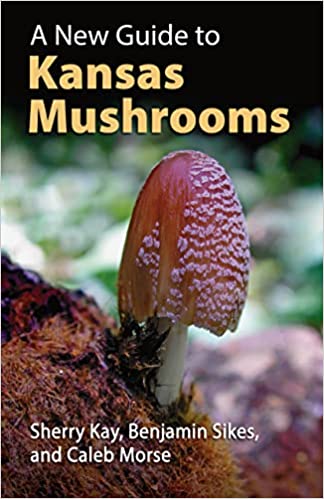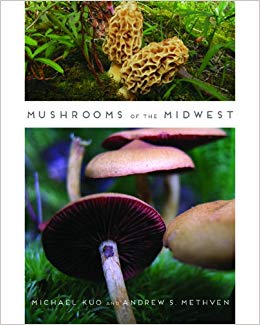Kansas is a land of contrasts, thanks in large part to its position in the center of a continent, far from the moderating influence of any ocean[i]. Violent weather is not uncommon, and while parts of the state have a subtropical climate, winters can be bitterly cold—or weirdly hot. And while Kansas is famous for its prairie and its agricultural lands, it also has its rivers and even forests.
Naturally, it also has its mushrooms, far more than we can cover in a quick little article like this one, but we can give you a glimpse of what the state has to offer[ii].
Please don’t go out foraging with this article as your guide. We say this, not because mushrooms are actually that hard to identify (OK, some of them are), but because there is a learning curve that is a good deal higher and steeper than you might realize standing at the bottom of it. Beginners can learn the field-marks of a couple of good edibles easily enough, but if you don’t yet have a good sense of how much variation is normal and what details are likely to be important, then you can be confused by a lookalike that would not bother an experienced forager.
Yes, getting to the point where you can safely forage for edible wild mushrooms takes work. We’re here to show you why the work is worth it.
If you do indeed go Mushroom Hunting make sure you have the proper tools, take a quality knife with you and a basket/bag for your haul!
This article is just some encouragement to help get you up that learning curve. This list is not meant to be used as a replacement for a field guide, spore prints, an identification app or an in person guide.
Our Recommended Field Guides for Kansas
COVER | TITLE | Header | ||
|---|---|---|---|---|
OUR #1 RATED | ||||
Edible Mushrooms
Shaggy Parasol (Chlorophyllum rhacodes)
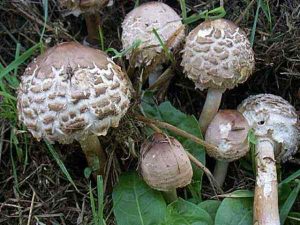

This mushroom is part of a small group of species that are particularly confusing—not only have some of the species in the group been re-defined recently, making it difficult to be sure which one someone is really talking about, but these are mushrooms that are safe and enjoyable to eat sometimes, but at other times unpleasantly poisonous. C. rhacodes is one of the safest, provided it is properly cooked, though confusion with the less-safe species is always a risk. The shaggy parasols are large, handsome, white mushrooms, which means confusion with the far more dangerous Destroying Angel is also a risk.
Wine-cap Stropharia (Stropharia rugosoannulata)
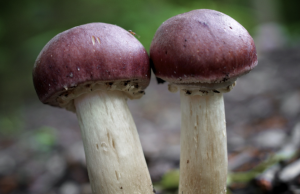

The Wine-Cap or King Stropharia is a popular edible with an oddly potato-like taste and an attractive, burgundy-colored cap. The species may or may not be native to North America but definitely grows on the continent now. Curiously, this fungus is a predator, growing tiny underground lassos that trap and hold nematode worms for digestion. Gardeners sometimes introduce this species to their plots to control nematodes. Most Stropharia species are not edible, this one is an exception, so proper identification is especially important.
Lobster Mushroom (Hypomyces lactifluorum)
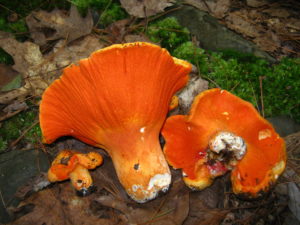

The Lobster Mushroom isn’t exactly a mushroom. Rather, it’s what happens when any of two groups of mushroom species are attacked by another fungal species, Hypomyces lactifluorum. The presence of the attacker alter’s the victim’s fruiting body in a characteristic way, producing the lobster mushroom, so called because it has an orange crust on the outside that looks a bit like a lobster shell. The flavor is subtly lobster-like as well. Curiously, regardless of which species the victim belongs to, the transformed lobster mushroom always looks and tastes the same.
Velvet Foot (Flammulina velutipes).
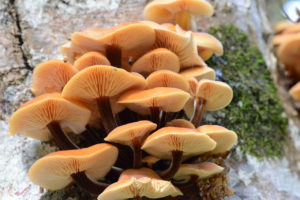

Velvet foot has a dual identity. When it grows in the wild, it is a fairly typical-looking LBM (“little brown mushroom”) that likes growing on wood—meaning that confusion with the wood-loving and aptly-named Deadly Galerina is a real possibility. Those who can tell the difference reliably can get an enjoyable meal, however. But when this species is grown in a dark environment with restricted airflow, its fruiting bodies end up very different—tall, skinny, with tiny caps and a white or whitish color, rather like bean-sprouts. Grown in that way, this species is known by the Japanese name, Enokitake or, for short, Enoki. It’s a delicacy.
Morels (Morchella sp.)
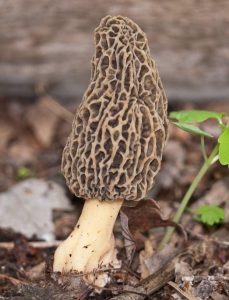

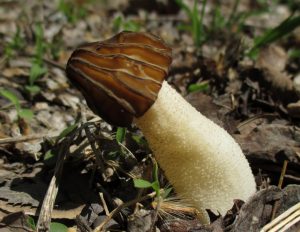

The morels are a very distinctive and popular group of edible mushrooms, although even properly cooked specimens occasionally make some people sick—either morels themselves vary or human sensitivity does or both. Still, many people are willing to take the risk for a dish of morels cooked in cream sauce. It’s fairly easy to tell that something is a morel—their caps are narrow and hug the stem, rather like a thimble on a finger, and are pitted like a honeycomb. There are morel lookalikes, mostly toxic, but they are wrinkled rather than pitted. Also, most morels have caps fused to the stem, and the one exception is still half-fused, whereas the lookalikes have stems that attach to the cap only at the top.
Figuring out which morel you have is harder, as they vary a lot and also change with age, to the point that some common names actually refer to multiple species, while some species have multiple common names. Kansas has at least two species, the White Morel (Morchella americana), and the descriptively-named Half-Free Morel (Morchella punctipes).
Hericium sp.
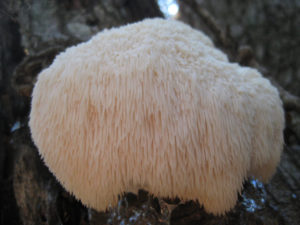

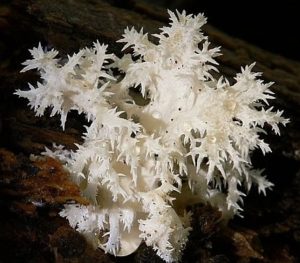

Lion’s Mane (Hericium erinaceus) is the most famous of the Hericiums, and it does grow in Kansas. It fruits from wounds in living or dead trees and is large, club-shaped, and covered all over with hairlike spines. Young specimens are white, but they yellow with age. Lion’s mane is reputed to have medicinal potential and, moreover, tastes remarkably like crab meat. Surprisingly, the hairlike spines don’t cause an odd texture in the mouth. Some writers refer to all Hericiums as “Lion’s Mane” and treat them as interchangeable. The others are edible and taste similar, but that doesn’t automatically mean they have the same medicinal potential. The others haven’t been studied. Kansas has at least one other, the Coral Tooth (Hericium coralloides), which branches like certain species of soft coral do, and has very short spines.
Edible Agaricus sp.
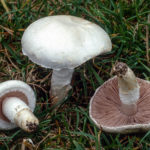

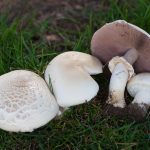

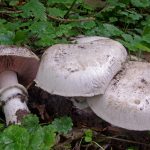

You may know that the familiar store-bought mushrooms, the White Buttons, the Criminis, the Portobellos, are all the same species—but what is the common name of that species? Turns out, it’s “Mushroom.”
That’s right, the word Mushroom started out as the common name for just one kind, and now the word is used to refer to basically any fungal fruiting body that you can pick up (as opposed to crusts, fuzzes, and spots). So, technically, “wild mushroom” should refer to the close relatives of that one domestic species, right? By that definition, Kansas does have several wild mushroom species, at least three of which are safe to eat: Meadow Mushroom (Agaricus campestris)[iii], Horse Mushroom (Agaricus arvensis)[iv], and Pavement Mushroom (Agaricus bitorquis)[v], though a mushroom actually growing out of pavement could well be contaminated by toxic road runoff. All are recognizably similar to their domestic cousin and to each other. Color is variable, from white or yellowish to brown. This first two are considered choice, the third rather less so.
There are also poisonous Agaricus mushrooms, and all of these mushrooms could also be mistaken for a Destroying Angel or the more toxic Shaggy Parasol species, so proper identification here is important.
Edible Puffballs










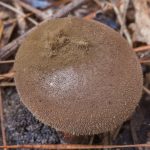

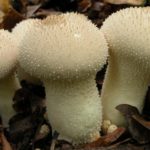



A puffball is any ball-shaped fungal fruiting body with the spores developing inside the ball. Curiously, there are multiple groups of puffballs that are entirely unrelated to each other. “Puffball” is a growth form, not a taxonomic group.
Some puffball groups are toxic or unpalatable, but the puffs of the genera, Lycoperdon and Calvatia are good eating—just make sure to identify them properly! Also, harvest them young. Once the spores begin to mature, puffs are no longer good to eat.
Kansas has at least eight species: Purple-Spored puffball (Calvatia cyathiformis); Giant Puffball (Calvatia gigantea); and Brain Puffball (Calvatia craniiformis) in one genus, and Spiny Puffball (Lycoperdon echinatum); Meadow Puffball (Lycoperdon pratense); Umber-Brown Puffball (Lycoperdon umbrinum); Common Puffball (Lycoperdon perlatum); and Peeling Puffball (Lycoperdon marginatum) in the other.
Inkcaps
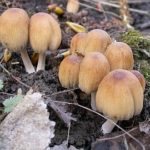

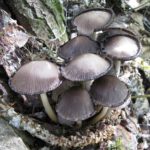

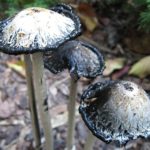

Inkcaps are an interesting group in that the mushrooms disperse their spores not by releasing them to the wind but by turning their gills to inky goo. In some, the entire mushroom goos itself and drips away. Before the mushroom goes gooey though, you can eat them. The goo itself is actually edible, too, just not palatable. Note that picking these mushrooms does not delay gooification, and may actually hurry it up—these delicacies don’t have much of a shelf-life, so you have to eat them soon!
Not all inkcaps are good to eat. Some are very small, and some may be toxic. Curiously, some inkcaps are described by some writers as edible and others as toxic. The deal is that these mushrooms contains a substance that is harmless unless you also drink alcohol the same week, at which point you get sick. For some people, that’s not a problem. For others, it evidently is.
Also of note is that Destroying Angel is sometimes mistaken for certain inkcaps and eaten, despite the fact that the resemblance is not close. Perhaps these are cases of wishful thinking. Anyway, don’t assume you couldn’t make the same mistake. Identify carefully.
Kansas has at least seven species, though only three are considered edible: Mica Cap (Coprinellus micaceus)[vi]; Common Inkcap (Coprinopsis atramentaria)[vii]; and Shaggy Mane (Coprinus comatus)[viii]. Only that last is considered safe to eat in the same week as alcohol.
Stinkhorns




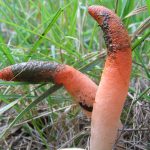

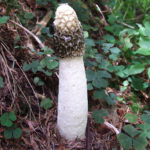

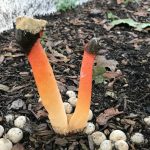

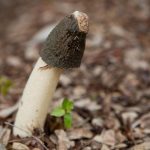

Stinkhorns are strange-looking and unpleasant-smelling mushrooms that many Americans consider obviously inedible—and yet at least some stinkhorns are popular food items in other countries. It’s usually the “egg stage” that is harvested, when the young mushroom is entirely enclosed in a soft shell of tissue that later splits. Note that Amanitas also have an egg stage, and that it is absolutely critical to not mix up an edible (if odd) stinkhorn egg with the egg of one of the toxic Amanitas.
Kansas has at least seven stinkhorn species, though it’s hard to find information on how many are edible, since so few writers even consider eating them: Lantern Stinkhorn (Lysurus mokusin); Dune Stinkhorn (Phallus hadriani); Wrinkly Stinkhorn (Phallus rugulosus); Devil’s Dipstick (Mutinus elegans); Common Stinkhorn (Phallus impudicus); Devil’s Stinkhorn (Phallus rubicundus); and Ravenel’s Stinkhorn (Phallus ravenelii).
Note that the Phallus genus name is not some giggly coincidence; most of these look even more like penises than most mushrooms do, and mycologists notice these things when they’re thinking up names. But not all stinkhorns look like mammalian genitalia—some look like Wiffle Balls, octopuses, or other things!
Our Recommended Field Guides for Kansas
COVER | TITLE | Header | ||
|---|---|---|---|---|
OUR #1 RATED | ||||
Poisonous Mushrooms
Most mushrooms are not poisonous, and most of the ones that are will only make you feel icky for a few hours. But nobody likes feeling icky, and there are a few that can kill. You need to know about those. This list is by no means exhaustive—Kansas has poisonous mushrooms that we don’t cover here—but we wanted to give you an idea of what’s out there.
Also, some poisonous mushrooms are pretty or interesting or otherwise worthy of study. Not everything has to be edible.
Flowerpot Dapperling (Leucocoprinus birnbaumii)
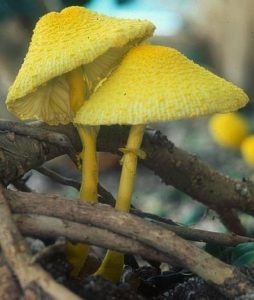

The flowerpot dapperling is, indeed, a dapper little fellow that often grows in flowerpots—it is a tropical species that has traveled around the world in the soil of exotic houseplants. If the local climate is warm enough, it escapes into the wild. It can’t harm the houseplants it lives among, as it eats only dead organic matter, and it will not harm you unless you eat it. Do not eat it.
Jack O’Lantern (Omphalotus illudens)
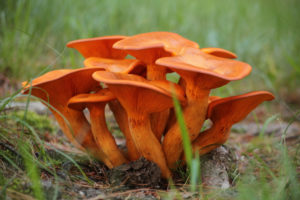

Jack o’lantern mushroom is famous for resembling chanterelles and glowing in the dark. Both are debatable (it is close to the same color as some Chanterelle Species, and most mushrooms are not). It’s also well-known for being poisonous, and that is not debatable. It probably won’t kill you, but you’ll wish you hadn’t eaten it. There are multiple Jack o’Lantern species in the world, and writers sometimes mix up their scientific names, but this is the species in Kansas.
Earthballs (Scleroderma sp.)
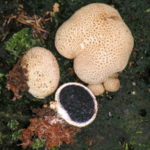

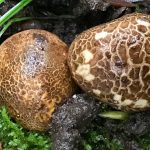

Earthballs are a group of poisonous puffballs. They differ from the edible puffs in having a thicker skin, in being more firm overall, and in having interior flesh that darkens relatively young. The Earthball group is large, and determining which one you have can be difficult without a microscope, but the main thing is not to eat any of them. Kansas has at least two species, the Common Earthball (Scleroderma citrinum) and the Onion Earthball (Scleroderma Cepa).
Yellow Stainer (Agaricus xanthodermus)
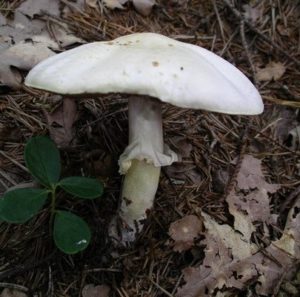

The Yellow Stainer is one of several poisonous members of the mushroom group—that is, the group of species closely related to those white buttons found in grocery stores. It is frequently mistaken for its edible relatives and causes unpleasant gastrointestinal upset in most people. A few people can eat this mushroom safely, and nobody knows why. This is a white or whitish mushroom that turns yellow when bruised, but its scent is unpleasant and even more distinctive[ix].
False Parasol (Chlorophyllum molybdites)
Remember when we said that Shaggy Parasol is one of the safest of a group of sometimes-poisonous species? Well, the false or Green-Spored Parasol is at the other end of the continuum. It is almost always poisonous, even when well-cooked. You probably won’t die from eating it, but will get very, very sick. It looks very much like other members of the group but is much more likely to have green spores.
Deadly Galerina (Galerina marginata)


This species is the primary reason (although there are others) to think twice before eating any LBM. Not only does the aptly-named Deadly Galerina look like several culinary species and most of the magic mushrooms, it also shares the same habitat with some of them and can fruit in mixed clusters with its edible look-alikes. Its toxin also has a delayed onset, meaning that when you get sick, you might not think to tell your doctor about the mushrooms you ate the day before. That means you might not get the prompt and well-informed medical attention that might save your life. Maybe.
Just don’t eat this, folks.
Destroying Angel (Amanita bisporigera)
The Destroying Angels are a group of large, white or whitish, very handsome mushrooms species that have the same toxin as the Deadly Galerina. A. bisporigera is simply the one of the group that grows in Kansas. It’s a curious thing that while destroying angels are very distinctive-looking, they are not-infrequently mistaken for virtually any edible white or whitish mushroom, including edible Agaricus species, shaggy parasols, and shaggy mane inkcaps. Not only do beginners make this mistake, but so do experienced foragers. Possibly the problem is that people become complacent, believing that they could never make such an obvious error, and so neglect to do the careful identification work necessary for foraging?
You’re never too smart to be dumb, people.
It’s easier to understand how destroying angels could be mistaken for puffballs since Amanitas have an initial “egg” stage that does look very puffball-like. The key is to slice any puffball you want to eat in half vertically so you can inspect the interior for the tell-tale signs of a developing Amanita-like structure.
Our Recommended Field Guides for Kansas
COVER | TITLE | Header | ||
|---|---|---|---|---|
OUR #1 RATED | ||||
Magic Mushrooms
Kansas doesn’t have a lot of psychoactive species growing wild, but it does have at least two[x]. Before attempting to harvest either of these, please remember that doing so is extremely illegal and also that these mushrooms do closely resemble the Deadly Galerina. Stay safe.
Banded Mottlegill (Panaeolus cinctulus)
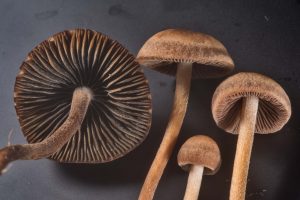

The Pans, or Mottlegills are so called because their spores develop unevenly, causing black patches on the gills. Some Mottlegills are powerfully psychoactive, whereas others are not psychoactive at all. This widespread species is in the middle, less potent than, say, Psilocybe cubensis, but still able to alter the mind.
Gymnopilus pulchrifolius
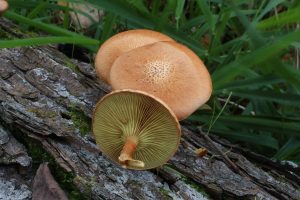

Pulchrifolius, and members of the Gymnopilus genus are often called Rustgills. We’ve been unable to track down an existing common name for this mushroom, nor is there much information about it at all, but it does seem to contain enough psilocybin to be at least weakly psychoactive.
References:
[ii] (n.d.). Mushrooms of Kansas. iNaturalist
[iii] (n.d.). Agaricus campestris L. –Field Mushroom. First Nature
[iv] (n.d.). Agaricus arvensis Schaeff. –Horse Mushroom. First Nature
[v] (n.d.). Agaricus bitorquis (Quél.) Sacc. –Pavement Mushroom. First Nature
[vi] (n.d.). Coprinellus micaceus (Bull.) Vilgalys, Hopple & Jacq. Johnson –Glistening Inkcap. First Nature
[vii] (n.d.). Coprinopsis atramentaria (Bull.) Redhead, Vilgalys & Moncalvo—Common Inkcap. First Nature
[viii] (n.d.). Coprinus comatus (O.F. Müll.) Pers.–Shaggy Inkcap. First Nature
[ix] (n.d.). Agaricus xanthodermus Genev.—Yellow Stainer. First Nature
[x] (n.d.). Which Psilocybin Mushrooms Grow Wild in My Area? Shroomery



